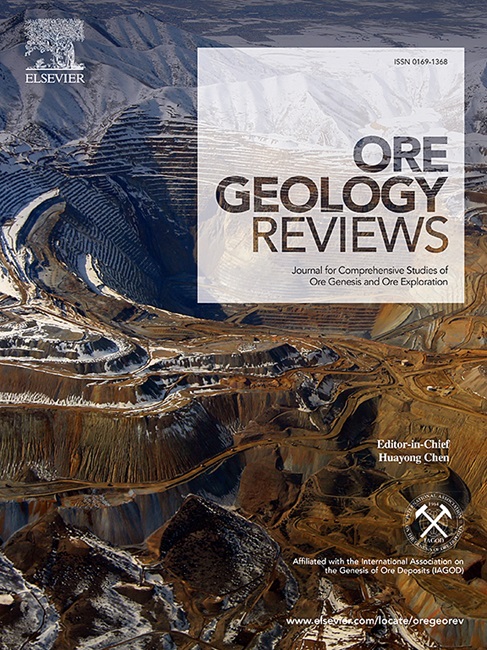Shortwave infrared (SWIR) spectroscopy for greenfield exploration: Investigating the Bayi-Muchang prospect within the Jiama giant Porphyry-Skarn system
IF 3.2
2区 地球科学
Q1 GEOLOGY
引用次数: 0
Abstract
Jiama is a giant porphyry-skarn system (1,814 Mt ore @ 0.40 % Cu) within the Gangdese porphyry copper belt, Southern Tibet. Recently, copper, molybdenum, and tungsten anomalies, similar to those at Jiama, have been identified in the Bayi-Muchang prospect southwest of the deposit. However, the mineralization potential of this peripheral area and its genetic connection to Jiama remain poorly constrained. This study employs shortwave infrared (SWIR) spectroscopy to map alteration minerals in both the Bayi-Muchang prospect and compare them to those in the southwestern Jiama deposit. SWIR spectral results reveal that the Bayi-Muchang prospect is dominated by chlorite, phengite, quartz, and less carbonates from chlorite-sericite alteration with minor epidote and chlorite vein-halos, as well as pervasive propylitic assemblages with chlorite, epidote, and less carbonates, indicating the presence of an independent hydrothermal center where ore-forming fluids were concentrated and exsolved rather than an extension of the Jiama deposit. Key spectral indicators for mineralized zones, derived from Jiama samples, including wavelength of 2200 nm feature longer than 2207 nm and the illite spectral maturity higher than 1.4 in white mica, as well as the full width at half maximum (FWHM) of 2335 nm feature longer than 36 nm in carbonate minerals. Additionally, carbonate minerals in the Duodigou Formation north of Bayi-Muchang record a contact metamorphism gradient, with the FWHM of the 2335 nm feature increasing from 36 to 56 nm from south to north. The northwest Bayi-Muchang area, near the hydrothermal center, is identified as a favorable target for skarn-type and porphyry-type mineralization. This study highlights the effectiveness of SWIR spectroscopy mapping in supporting exploration strategies within porphyry-skarn systems, particularly for greenfield targets.

求助全文
约1分钟内获得全文
求助全文
来源期刊

Ore Geology Reviews
地学-地质学
CiteScore
6.50
自引率
27.30%
发文量
546
审稿时长
22.9 weeks
期刊介绍:
Ore Geology Reviews aims to familiarize all earth scientists with recent advances in a number of interconnected disciplines related to the study of, and search for, ore deposits. The reviews range from brief to longer contributions, but the journal preferentially publishes manuscripts that fill the niche between the commonly shorter journal articles and the comprehensive book coverages, and thus has a special appeal to many authors and readers.
 求助内容:
求助内容: 应助结果提醒方式:
应助结果提醒方式:


